 |
Corinth is situated at the north east part of the Peloponessos
and developed as important place for sea trade. They took
the lead in trade with the East and introduced eastern elements
to vase-painting. Then they developed so called Orientalizing
style.
It is noticeable that their main products are smaller vessels,
such as jugs and perfume pots. Different from Attic pottery,
Corinthian clay has less iron and it makes the colour into
buff yellow after fired. The common decoration schemes are
animals, such as lions and panthers, and monsters, such as
sphinxes and griffins. But the most important innovation is
the technique for decoration.
With this so called black figure technique, figures are depicted
as silhouette, then the details are represented by engraved
lines and white and purple are sometimes added for accent.
Corinthian pottery in the Orientalizing period is named "Protocorinthian".
On middle Protocorinthian pottery, painters introduced mythological
scenes [1]. The Chisi Vase (villa giulia) is the masterpiece of this period. This is the
first time in the history of Greek art that Greek hoplies
are represented. In the middle frieze has the judgement of
Paris, while the lower frieze has a hunting scene.
In the second half of the seventh century, figures became
bigger and more details were added, while the composition
and style were mannered and many patterns such as rosettas
occpied the background. Now the Corinthian pottery turned
into new phase, Corinthain pottery [2]. Although
occasionally human figures are depicted, most vases are filled
with animal friezes (fig.1), which were followed by workshops in many other regions,
such as of Attica, East Greek and Etruskan.
Other than vessels, Corinthain painters occasionally painted
on votive plaques (fig.2), on which potter's workshops are often represented. In the
later period, when they were menaced by fine vases of Athenian
workshops in pottery market, Corinthain workshops introduced
more mythological scenes (fig.3) and larger vessels (fig.4,fig.5)[3].
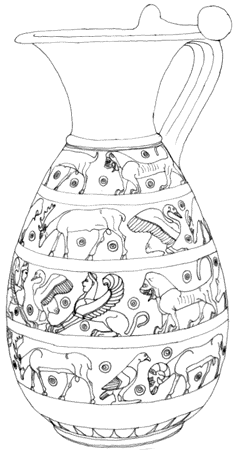
Fig.1
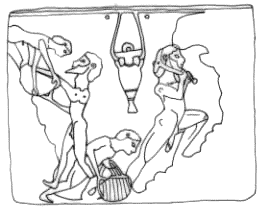
Fig.2
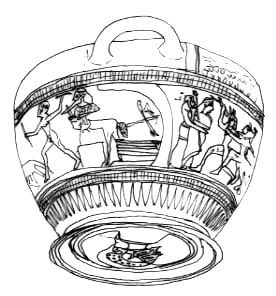
Fig.3
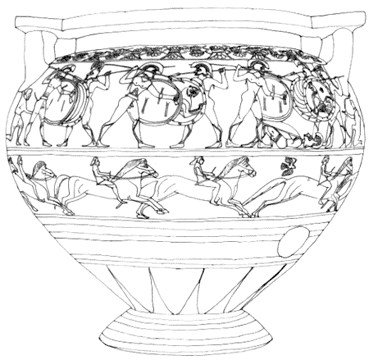
Fig.4
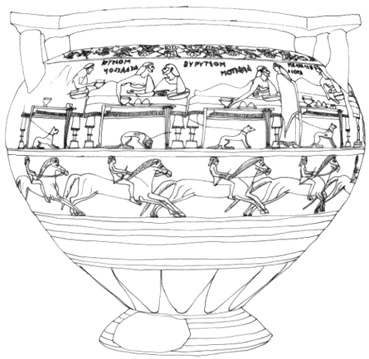
Fig.5
Although the neck amphora in Paris dated to
c.550 cannot be greater than contemporary Athenian pottery,
it is noticeable that the story of the death of Ismene, daughter
of Oidipus, is represented, since the story is not preserved
in any literary sources (fig.6). In the second half of the sixth century, Corinthain workshops
abandoned figure decoration on their vessels.
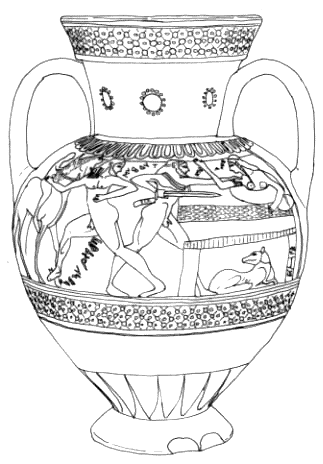
Fig.6
| [1] |
For Protocorinthain
pottery, see, Johansen, K. F., Les
vases Sicyoniens, (1923), Payne, H., Protokorinthische
Vasenmalerei, (1933), Dunbabin, T. J. and Robertson,
M., "Some Protocorinthian vase-painters", BSA
48, pp.172-181. |
| [2] |
For Corinthain
pottery, see, Payne, H., Necrocorinthia: a study of Corinthian
art in the Archaic period, (1931), Hopper, R. J., BSA
44, pp.162-257, Benson, J. L., Earlier Corinthian Workshops,
(1989), Amyx, D. A., Corinthian vase-paintings of the
Archaic period, (1988), Neeft, C. W., Addenda et Corrigenda
to D. A. Amyx, CorVP, (1991). |
| [3] |
For Late
Corinthain pottery, see, Campbell, M. T., Hesp. 7, pp.560-564. |
|
 |